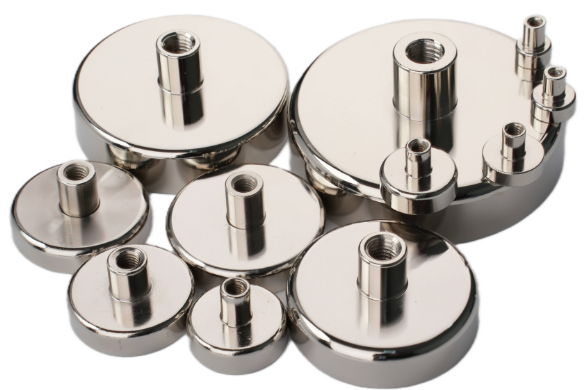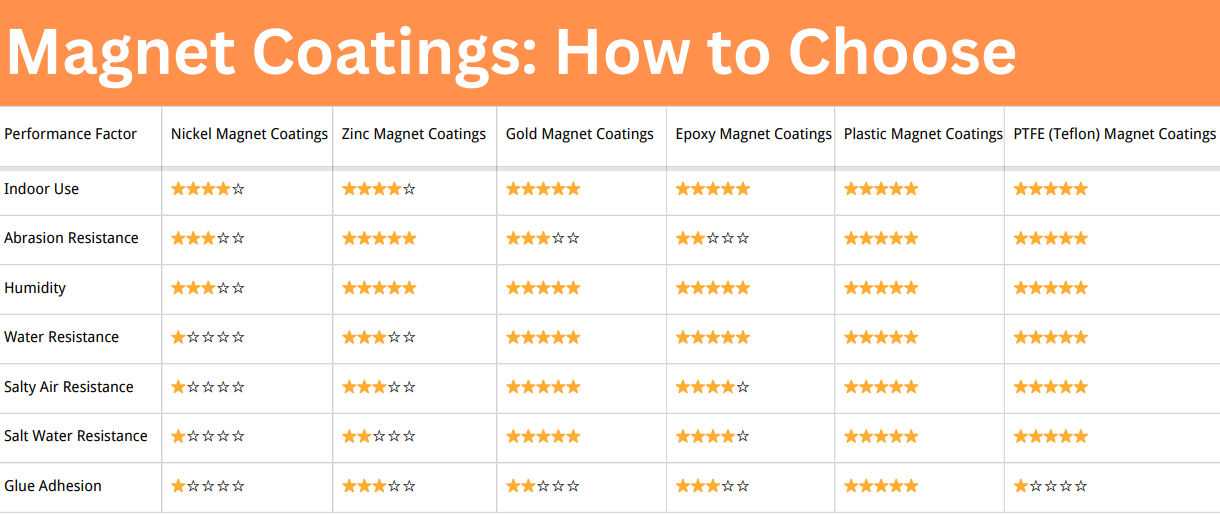Understanding Mounting Magnets: Types, Strengths, and Uses
Mounting magnets are heavy-duty, reusable fastening systems that are used in a wide range of industries—from manufacturing and construction to retail displays and do-it-yourself applications. Designed to hold securely without drilling, welding, or adhesives, mounting magnets offer ease of use, versatility, and clean installation.
What Are Mounting Magnets?
Mounting magnets, holding magnets, or magnetic mounts are magnet assemblies housed in a plastic or metal casing to make installation easy. They typically include:
- A magnet core (neodymium, ferrite, or AlNiCo)
- A steel cup or housing that redirects and concentrates the magnetic field
- A mounting feature such as a threaded hole, countersunk hole, hook, or rubber coating
These elements combined provide a secure, stable magnetic hold on ferromagnetic surfaces like iron or steel.

Mounting Magnets Types
1. Pot Magnets (Cup Magnets)
Pot magnets consist of a round magnet encased in a steel pot. They include threaded holes, countersunk holes, or studs for mounting. They are powerful in their pull due to the magnetic circuit enhancement and are ideal for tool holders, signage, fixtures, and jigs.
Further reading: What Are the Types of Pot Magnets?
2. Countersunk Magnets
These are disc magnets with a hole in the middle and a 90-degree countersink and are screwed flush into wood, plastic, or metal. They possess a moderate holding power and find applications in furniture, closures, and wall-mounting.
3. Threaded Stud Magnets
These are pot magnets with threaded studs for bolt-on applications. They possess strong holding power and are utilized for mounting brackets, sensors, lights, or fixtures in industrial environments.
4. Rubber-Coated Magnets
These magnets are covered in rubber for increased slip resistance and to avert damage to painted or delicate surfaces. They have high strength and are very well suited for outdoor and marine conditions or vehicle-mounted devices.
5. Hook and Eyebolt Magnets
These are removable hooks or eyelets on pot magnets. They offer secure strength for hanging items such as tools, cables, lights, or banners.
Understanding Strength and Pull Force
Pull force is the maximum vertical force needed to remove a magnet from a thick, flat steel surface under ideal conditions.
|
Magnet Type |
Typical Pull Force |
Key Factors |
|
Pot Magnet (Neodymium) |
Up to 300 lbs (136 kg) |
High-grade alloy, steel cup design |
|
Ferrite Magnet |
5–50 lbs (2–23 kg) |
Economical, lower strength |
|
Rubber-Coated Magnet |
10–150 lbs (4–68 kg) |
Surface friction affects performance |
|
Hook Magnet |
10–200 lbs (4–90 kg) |
Directional force and mounting surface |
Actual strength will vary depending on surface finish, thickness, flatness, orientation, and environmental factors such as paint or rust. For more information, please check Stanford Magnets.
Applications and Advantages of Mounting Magnets
Mounting magnets are reusable, easy to install, and require no surface modification. They save time, reduce damage, and offer an aesthetic solution compared to screws, nails, or adhesives. You'll find them in the following applications:
- Industrial Assembly and Fixtures
Mounting magnets are used for positioning or temporary holding of metal parts during welding, machining, or inspections.
- Retail Display and Signage
They provide a damage-free, clean way of mounting signs, banners, and shelves in retail environments.
- Vehicle and Marine Use
Rubber-coated magnets are used for mounting items such as antennas, lights, or trackers without damaging paintwork.
- Furniture and Cabinetry
Countersunk magnets are used as concealed closures for cabinet doors and panels.
- Sensor and Camera Mounts
Mounting magnets provide easy adjustability and secure placement of cameras, inspection devices, or motion sensors.
Mounting Magnets vs. Conventional Fasteners: Cost and Reusability
While adhesives, nails, and screws are less expensive initially, they come with installation time, potential surface damage, and a lack of flexibility. Mounting magnets are reusable and offer long-term savings in adjustable or temporary applications. They also eliminate the need for drilling or repairs—ideal in leased property, painted walls, or precision installations.
5 Things to Know Before Buying Mounting Magnets
- Surface Compatibility: Magnetism varies by material and surface texture.
- Pull Force Ratings: Understand the difference between laboratory-rated force and actual performance.
- Environment: Consider exposure to water, temperature, or vibration—use coated or sealed magnets accordingly.
- Mounting Style: Choose suitable hardware—threaded, countersunk, hook, or rubber-coated—based on your application.
- Safety: Strong magnets can pinch skin or damage electronics—handle carefully.
Conclusion
Mounting magnets provide an efficient and strong semi-permanent or temporary fastening solution for industrial, commercial, and consumer uses. Mounting magnets are provided in various configurations, such as pot magnets, threaded mounts, and rubber-coated magnets, which provide high holding power with the advantage of flexibility and simplicity of use. The proper selection of mounting magnet ensures an effective and clean installation that is specific to your application.














